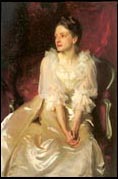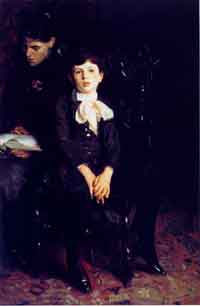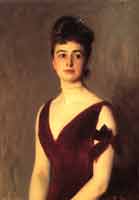
Administration Building and Plaza
Columbian Exposition
Jpg: World Columbian Exposition
| Theodore
Robinson
American Impressionist Painter, 1852-1896 World's Colombian Exposition, 1894 1894 Richard and Jane Manoogian colletion Oil on canvas 25 x 30 in |
Miss Ellen Terry
as Lady Macbeth
1889



Miss Helena Dunham 1892 |

Homer Saint-Gaudens and his Mother 1890 
Alice Vanderbilt Shepard 1888 |
Lady Agnew
1892-93
Sargent sent eight paintings to Chicago for the Columbian Exposition and got top billing with Whistler.
I have excerpted from the official Illustrated publication dealing with United States artists and Sargent:
The eccentric Mr. WHISTLER has elected to exhibit in the American section altogether — possibly remembering the unpleasantness which is said to have attended his transferral from one nation to the other at the Paris Exposition of 1889; and Mr. SARGENT, who is practically a man without a country but none the less lucky and exalted, displays a brilliant array of his portraits. Painters as far apart in everything a Mr. VEDDER in Rome, Messrs. WEEKS and HARRISON in Paris, and Mr. ABBEY in London, all send home loyally their most important works to help swell the chorus that proclaims the greatness of American art.NotesAmong the most interesting and important of these picked canvases is Mr. Sargent's portrait of Miss Ellen Terry as Lady Macbeth [pictured left], owned by Henry Irving and first exhibited at the New Gallery in Regent street in the Spring of 1889. It was not there hung, as at Chicago, as a "centre," but it blazed out even more vehemently among the pale and respectable English pictures. The British matron paused a moment before it, said "Oh! I don't like that!" and passed on. The painter undertook to epitomize the tragedy of "Macbeth" in the portrait of an actress; he gave her an attitude — holding the crown of Scotland poised over her head with both hands — which she nowhere assumes in the play, and he took the sober and harmonious tones of her costume and her braided hair and pushed them up in the scale to a pitch of barbaric splendor and color. The face is very pale and with all the actress' tricks of "make-up" and expression accentuated by the courageous painter, the attitude is fierce and proud, the likeness is evident, — it is a portrait and a drama, both at once. Of more conventional sitters there are seven of Mr. Sargent's presentations, all of them marked by his well-known characteristics, the sort of keying-up of attitude and expression and color, the strong individuality, the unmistakable life in the face and figure. In one lent by Mr. Augustus St. Gaudens Portrait of a Boy [Homer Saint-Gaudens and His Mother], the mother reads quietly, a little in the shadow, while her small son standing by her knee, looks at you; another [Miss Helena Dunham] is lent by Mr. Dunham of New York, the three-quarter length of a handsome lady in white with her hands suddenly clasped in her lap; [Alice Vanderbilt Shepard] the half length of a charming young girl with very black hair and eyes, is owned by Mr. E. F. Shepard of New York; the portrait of Mrs. Inches is very proud and spirited, her purple velvet dress skillfully and summarily painted. In addition to all these Mr. Sargent sends the only study of the nude he has exhibited, the full-length, life-size, figure of a slender Egyptian girl, standing with her back to the visitor but obligingly twisting herself round on her supple waist to braid the long locks of her black hair and show him her pretty Oriental profile. Near this picture, which the chaste commissioners have banished to a screen in the upper galleries, hangs another life-sized painting of unashamed nudity by Mr. BRIDGMANN, startlingly white in itself and rendered still whiter by the contrast with the smooth olive tints of the Egyptienne. It is worthy of remark that Mr. Sargent's portrait of Lady Agnew in this year's Royal Academy is accepted as complete in its serenity and refinement as his portraits usually are in cleverness and dash.
(William Walton for the Official Illustrated publication of the Exposition -- Exposition Home Page )
The Exposition was wonderfully chronicled by William Walton. This book has been digitally reproduced on the web by the Paul V. Galvin Library.
- Exposition Home Page
- See the years in review 1892-93
- THE ART - VOLUME I,

